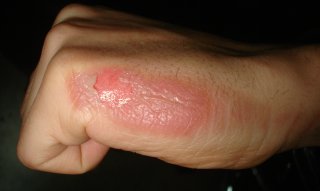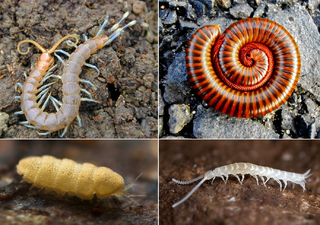
Millipedes are a group of arthropods that are characterised by having two pairs of jointed legs on most body segments; they are known scientifically as the class Diplopoda, the name derived from this feature. Each double-legged segment is a result of two single segments fused together. Most millipedes have very elongated cylindrical or flattened bodies with more than 20 segments, while pill millipedes are shorter and can roll into a tight ball. Although the name "millipede" derives from Latin for "thousand feet", no species was known to have 1,000 or more until the discovery in 2020 of Eumillipes persephone, which can have over 1,300 legs. There are approximately 12,000 named species classified into 16 orders and around 140 families, making Diplopoda the largest class of myriapods, an arthropod group which also includes centipedes and other multi-legged creatures.

Acute radiation syndrome (ARS), also known as radiation sickness or radiation poisoning, is a collection of health effects that are caused by being exposed to high amounts of ionizing radiation in a short period of time. Symptoms can start within an hour of exposure, and can last for several months. Early symptoms are usually nausea, vomiting and loss of appetite. In the following hours or weeks, initial symptoms may appear to improve, before the development of additional symptoms, after which either recovery or death follow.

Centipedes are predatory arthropods belonging to the class Chilopoda of the subphylum Myriapoda, an arthropod group which includes millipedes and other multi-legged animals. Centipedes are elongated segmented (metameric) creatures with one pair of legs per body segment. All centipedes are venomous and can inflict painful stings, injecting their venom through pincer-like appendages known as forcipules or toxicognaths, which are actually modified legs instead of fangs. Despite the name, no centipede has exactly 100 pairs of legs; the number of pairs of legs is an odd number that ranges from 15 pairs to 191 pairs.

An electrical injury, or electrical shock is damage sustained to the skin or internal organs on direct contact with an electric current.

A burn is an injury to skin, or other tissues, caused by heat, cold, electricity, chemicals, friction, or ultraviolet radiation. Most burns are due to heat from hot liquids, solids, or fire. Burns occur mainly in the home or the workplace. In the home, risks are associated with domestic kitchens, including stoves, flames, and hot liquids. In the workplace, risks are associated with fire and chemical and electric burns. Alcoholism and smoking are other risk factors. Burns can also occur as a result of self-harm or violence between people (assault).

A blister is a small pocket of body fluid within the upper layers of the skin, usually caused by forceful rubbing (friction), burning, freezing, chemical exposure or infection. Most blisters are filled with a clear fluid, either serum or plasma. However, blisters can be filled with blood or with pus.

Narceus americanus is a large millipede of eastern North America. Common names include American giant millipede, worm millipede, and iron worm. It inhabits the eastern seaboard of North America west to Georgetown, Texas, north of the Ottine wetlands. It has a nearly cylindrical gray body, reaching a length of 4 inches (100 mm). They can be commonly found in or under decaying logs from March to October. When threatened, they sometimes curl up or release a noxious liquid that contains large amounts of benzoquinones which can cause dermatological burns. This fluid may irritate eyes or skin. Many other millipedes secrete hydrogen cyanide, and while there have also been claims that N. americanus releases hydrogen cyanide, they are unsubstantiated. They do, however, excrete a substance that causes a temporary, non-harmful discoloration of the skin known as millipede burn.

An injury is any physiological damage to living tissue caused by immediate physical stress. Injuries to humans can occur intentionally or unintentionally and may be caused by blunt trauma, penetrating trauma, burning, toxic exposure, asphyxiation, or overexertion. Injuries can occur in any part of the body, and different symptoms are associated with different injuries.

Myriapods are the members of subphylum Myriapoda, containing arthropods such as millipedes and centipedes. The group contains about 13,000 species, all of them terrestrial.

A skin condition, also known as cutaneous condition, is any medical condition that affects the integumentary system—the organ system that encloses the body and includes skin, nails, and related muscle and glands. The major function of this system is as a barrier against the external environment.

Cupping therapy is a form of pseudoscience in which a local suction is created on the skin with the application of heated cups. As alternative medicine it is practiced primarily in Asia but also in Eastern Europe, the Middle East, and Latin America. Cupping has been characterized as a pseudoscience and its practice as quackery.

Fungal infection, also known as mycosis, is a disease caused by fungi. Different types are traditionally divided according to the part of the body affected; superficial, subcutaneous, and systemic. Superficial fungal infections include common tinea of the skin, such as tinea of the body, groin, hands, feet and beard, and yeast infections such as pityriasis versicolor. Subcutaneous types include eumycetoma and chromoblastomycosis, which generally affect tissues in and beneath the skin. Systemic fungal infections are more serious and include cryptococcosis, histoplasmosis, pneumocystis pneumonia, aspergillosis and mucormycosis. Signs and symptoms range widely. There is usually a rash with superficial infection. Fungal infection within the skin or under the skin may present with a lump and skin changes. Pneumonia-like symptoms or meningitis may occur with a deeper or systemic infection.

A radiation burn is a damage to the skin or other biological tissue and organs as an effect of radiation. The radiation types of greatest concern are thermal radiation, radio frequency energy, ultraviolet light and ionizing radiation.

The Hindenburg disaster was an airship accident that occurred on May 6, 1937, in Manchester Township, New Jersey, U.S. The LZ 129 Hindenburg was a German commercial passenger-carrying rigid airship, the lead ship of the Hindenburg class, the longest class of flying machine and the largest airship by envelope volume. It was designed and built by the Zeppelin Company and operated by the German Zeppelin Airline Company. It was named after Field Marshal Paul von Hindenburg, who was president of Germany from 1925 until his death in 1934. Filled with hydrogen, it caught fire and was destroyed during its attempt to dock with its mooring mast at Naval Air Station Lakehurst. The accident caused 35 fatalities among the 97 people on board, and an additional fatality on the ground.

Ichthyosis bullosa of Siemens is a type of familial, autosomal dominant ichthyosis, a rare skin disorder. It is also known as bullous congenital ichthyosiform erythroderma of Siemens or ichthyosis exfoliativa. It is a genetic disorder with no known cure which is estimated to affect about 1 in 500,000 people.

Sunburn is a form of radiation burn that affects living tissue, such as skin, that results from an overexposure to ultraviolet (UV) radiation, usually from the Sun. Common symptoms in humans and other animals include red or reddish skin that is hot to the touch or painful, general fatigue, and mild dizziness. Other symptoms include blistering, peeling skin, swelling, itching, and nausea. Excessive UV radiation is the leading cause of (primarily) non-malignant skin tumors, which in extreme cases can be life-threatening. Sunburn is an inflammatory response in the tissue triggered by direct DNA damage by UV radiation. When the cells' DNA is overly damaged by UV radiation, type I cell-death is triggered and the tissue is replaced.

A centipede bite is an injury resulting from the action of a centipede's forcipules, stinger-like appendages that pierce the skin and inject venom into the wound. Such a wound is not strictly speaking a bite, as the forcipules are a modified first pair of legs rather than true mouthparts. Clinically, the wound is viewed as a cutaneous condition characterized by paired hemorrhagic marks that form a chevron shape caused by the paired forcipules.
Lepidopterism is an irritant contact dermatitis caused by irritating caterpillar or moth hairs coming into contact with the skin or mucosa. When referring to the cause, moth dermatitis and caterpillar dermatitis are commonly used; Caripito itch is an older name referring to the moth dermatitis caused by some Hylesia species.
Microwave burns are burn injuries caused by thermal effects of microwave radiation absorbed in a living organism.

Narceus gordanus, also known as smokey oak millipede and smokey ghost millipede, is a species of spirobolid millipede native to the south-eastern United States. Adults range from around 60 to 120 mm in length, up to 13 mm wide, and possess 45 to 65 body segments. The body color is lighter than other species of the genus Narceus, with each body ring a light greenish tan followed by a band of darker tan. N. gordanus also has shorter legs than other Narceus species, and a deeper groove on the head in which the antennae rest.


















